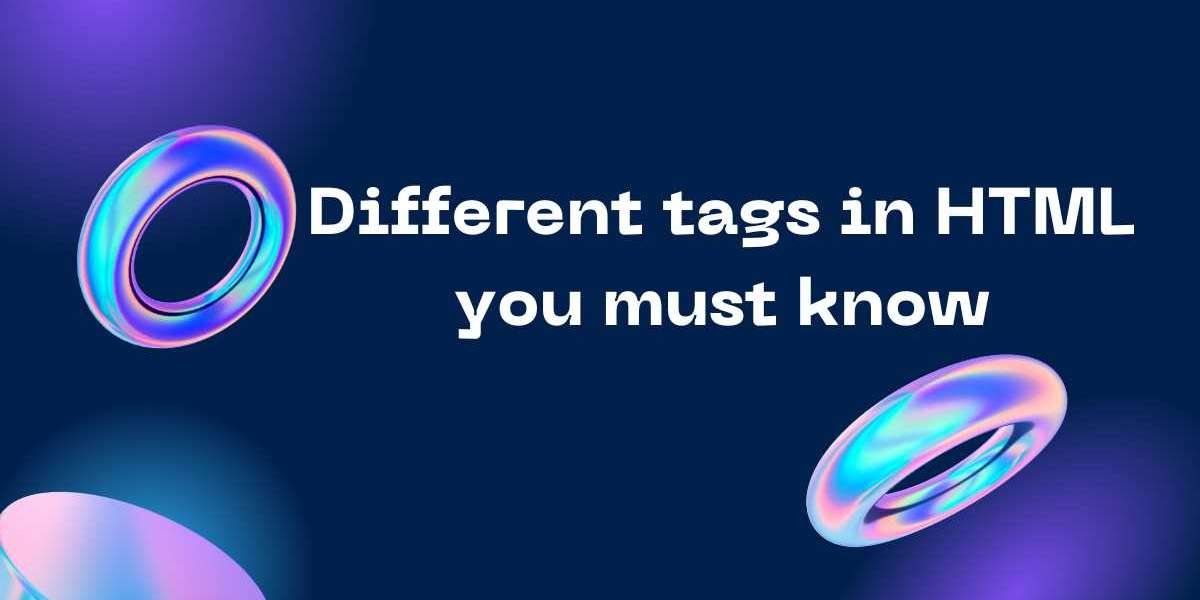Introduction
In the ever-evolving realm of web development, HTML (Hypertext Markup Language) plays a pivotal role in creating the structure and content of web pages. Understanding the different HTML tags is essential for anyone venturing into web development. In this comprehensive guide, we will delve into the world of HTML tags, including the frequently used 'span tag in HTML,' while also exploring the subtle differences between HTML and DHTML.
HTML Tags: The Building Blocks of the Web
HTML tags are the fundamental building blocks of any web page. They provide structure and formatting to the content, allowing web browsers to render it appropriately. Each HTML tag serves a specific purpose, and knowing when and how to use them is crucial for web developers. Let's start our journey through some of the most common HTML tags.
Heading Tags: Structuring Your Content
Heading tags are used to define headings and subheadings within a web page. They range from h1 to h6, with h1 being the highest level and h6 the lowest. These tags help create a hierarchy in your content, making it more organized and user-friendly.
For instance, if you want to create a main heading for your webpage, you would use the h1 tag. Here's an example:
```html
h1Welcome to My Blog/h1
```
Similarly, for subheadings, you can use h2, h3, and so on.
Paragraph Tags: Structuring Text Content
To create paragraphs of text on your webpage, you use the p tag. This tag is essential for breaking down your content into easily readable chunks.
```html
pThis is a sample paragraph of text. It can contain anything from plain text to images and links./p
```
Anchor Tags: Creating Links
Anchor tags, denoted by the a tag, are used to create hyperlinks to other web pages or resources. These tags require the 'href' attribute, which specifies the URL to which the link should navigate.
```html
a href="https://www.example.com"Visit Example.com/a
```
Image Tags: Embedding Images
To display images on your web page, you use the img tag. This tag also requires the 'src' attribute, which specifies the image file's location.
```html
img src="image.jpg" alt="A beautiful landscape"
```
List Tags: Organizing Content
HTML provides two types of lists: ordered and unordered. Ordered lists use the ol tag, while unordered lists use the ul tag. List items are defined with the li tag.
Ordered List Example:
```html
ol
liFirst item/li
liSecond item/li
liThird item/li
/ol
```
Unordered List Example:
```html
ul
liApples/li
liBananas/li
liOranges/li
/ul
```
Span Tag in HTML: Inline Styling
Now, let's take a closer look at the 'span tag in HTML.' The span tag is unique in that it is an inline tag, which means it is used to style a specific portion of text within a larger element, such as a paragraph. Unlike block-level elements like div, the span tag does not create a new line break.
Here's an example of using the span tag to change the color of a word within a paragraph:
```html
pThis is a span style="color: blue;"blue/span word in a sentence./p
```
In this example, the word 'blue' will be displayed in blue, while the rest of the sentence remains unaffected. The 'style' attribute allows you to apply various CSS properties to the text within the span tag.
Difference Between HTML and DHTML: Understanding the Contrast
Before we dive deeper into more HTML tags, let's take a moment to explore the Difference Between HTML and DHTML (Dynamic HTML). While both are integral to web development, they serve distinct purposes.
HTML (Hypertext Markup Language) is the standard language used to create the structure and content of web pages. It provides the basic elements and tags for defining text, images, links, and more. HTML is static and primarily focuses on presenting information in a structured format.
DHTML (Dynamic HTML), on the other hand, extends HTML's capabilities by adding interactivity and dynamic behavior to web pages. DHTML combines HTML, CSS (Cascading Style Sheets), and JavaScript to create interactive and animated web content. Unlike static HTML, DHTML allows elements on a web page to change, move, or respond to user interactions without requiring a page reload.
Difference Between HTML and DHTML:
- Interactivity: HTML is static and does not provide built-in interactivity. DHTML enhances web pages with interactive features using JavaScript and CSS.
- Dynamic Behavior: DHTML enables dynamic content manipulation, such as animations, dynamic menus, and real-time updates, which HTML cannot achieve on its own.
- User Experience: DHTML enhances the user experience by providing responsive and engaging web applications, while HTML is more suitable for static content presentation.
- Complexity: DHTML development is more complex due to the need for scripting languages like JavaScript and CSS for styling and animation.
- Compatibility: HTML is widely supported by all browsers, while DHTML may require additional consideration for cross-browser compatibility due to its use of advanced scripting and styling.
- Use Cases: HTML is suitable for static web pages, blogs, and informational websites. DHTML is essential for creating web applications, interactive games, and dynamic web content.
In summary, while HTML forms the foundation of web content, DHTML builds upon it to deliver dynamic and interactive user experiences.
More Essential HTML Tags
Now that we've covered the 'span tag in HTML' and explored the distinctions between HTML and DHTML, let's continue our journey by examining more essential HTML tags.
Div Tag: Container for Styling and Layout
The div tag is a versatile container element used for grouping and styling content. It is often employed to create layout structures and apply CSS styles.
```html
div style="background-color: #f0f0f0; padding: 10px;"
pThis is a div element with some text./p
/div
```
The div tag allows you to apply styles, set background colors, and create complex layouts, making it an essential tool for web designers.
Form Tags: Gathering User Input
Forms are crucial for collecting user input, such as text, checkboxes, radio buttons, and more. HTML provides a range of form-related tags, including form, input, textarea, select, and button.
Here's a simple example of a form:
```html
form action="/submit" method="post"
label for="name"Name:/label
input type="text" id="name" name="name" required
br
label for="email"Email:/label
input type="email" id="email" name="email" required
br
input type="submit" value="Submit"
/form
```
In this example, the form tag defines the form, and the input tags create text input fields for the user's name and email. The 'required' attribute ensures that users must fill in these fields before submitting the form.
Table Tags: Structuring Data
Tables are used to present data in a structured format. HTML provides several tags for creating tables, including table, tr (table row), th (table header), and td (table data).
Here's a simple table example:
```html
table
tr
thProduct/th
thPrice/th
/tr
tr
tdLaptop/td
td$800/td
/tr
tr
tdSmartphone/td
td$400/td
/tr
/table
```
This code creates a table with two columns: "Product" and "Price," along with two rows of data.
HTML5 Semantic Tags: Improving Accessibility
HTML5 introduced a set of semantic tags that enhance the accessibility and SEO-friendliness of web pages. These tags provide a more meaningful structure to your content.
Some commonly used semantic tags include:
- header: Represents the header or top section of a webpage.
- nav: Defines a navigation menu.
- article: Encloses self-contained content, such as a blog post.
- section: Defines a section of content within an article.
- aside: Represents content that is related to the surrounding content but can be considered separate.
- footer: Represents the footer or bottom section of a webpage.
Using semantic tags not only improves the readability of your HTML code but also helps search engines understand your content better.
Audio and Video Tags: Multimedia Integration
HTML5 introduced the audio and video tags for embedding multimedia content, such as audio and video, directly into web pages.
Audio Example:
```html
audio controls
source src="music.mp3" type="audio/mpeg"
Your browser does not support the audio element.
/audio
```
Video Example:
```html
video controls width="320" height="240"
source src="video.mp4" type="video/mp4"
Your browser does not support the video tag.
/video
```
The 'controls' attribute adds playback controls to both audio and video elements, allowing users to play, pause, and adjust volume.
Conclusion
HTML tags are the foundation of web development, allowing you to create structured and visually appealing web pages. Understanding the purpose and usage of different HTML tags, including the versatile 'span tag in HTML,' is essential for anyone aspiring to become a proficient web developer.
As we explored various HTML tags, we also took a moment to distinguish between HTML and DHTML, highlighting their respective roles in web development. While HTML provides the basic structure and content presentation, DHTML elevates web experiences with interactivity and dynamic behavior.
Whether you're building a simple blog or a complex web application, HTML remains at the core of web development. It's a language that continues to evolve, with new features and tags introduced regularly. By mastering the fundamentals of HTML, you lay a solid foundation for creating stunning and interactive web experiences.
So, keep exploring, experimenting, and expanding your knowledge of HTML tags, and you'll be well on your way to becoming a proficient web developer in no time.
In conclusion, HTML is the bedrock of web development, and understanding its diverse set of tags, including the 'span tag in HTML,' is essential for crafting effective web pages. While HTML provides the structure, DHTML takes it a step further by adding dynamic and interactive elements to web applications. By mastering these fundamental concepts, you'll be well-equipped to create engaging and functional websites. So, dive into the world of HTML, explore its tags, and embark on your journey to becoming a proficient web developer. Happy coding!








